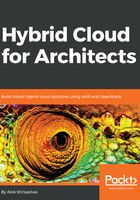
LAN architecture
Most people use the Cisco Campus reference architecture (three-tier architecture), or a variation, to implement the LAN of an underlay network. So traditionally, a standard data center architecture may include a core switch/router, a distribution layer, and finally an access layer. Access layers are for connecting end users and servers. The distribution and core layers help in dividing the LAN into smaller chunks by using the VLANs, then connect them using trunks such as dot1q trunks.

However, with the advent of more powerful switches, the switching architecture has now changed to a collapsed core architecture and sometimes even a fabric architecture (leaf-spine) with Cisco Nexus and Junipers QFabric leading the way.

In your data center, you will find either of the previously mentioned topologies or a variation there of.
The orchestration of this layer (if any) would include
- Creating a new VLAN and a new IP subnet for the VLAN
- Creating an SVI (Switched Virtual Interface) to act as default gateway for the IP subnet
- Enabling trunking for the new VLAN.
- Optionally, the deletion of the VLAN and modification to an already existing VLAN
It is to be noted, that normally these things are done on the overlay network, but with the advent of smarter and programmable devices, the underlay may soon be used.